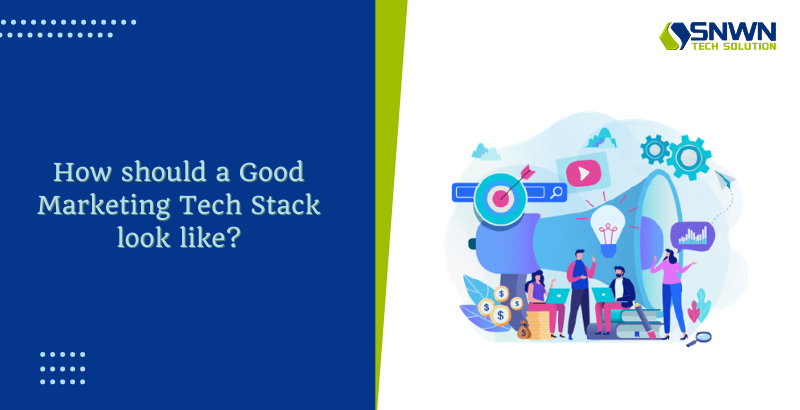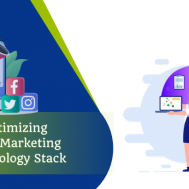The marketing technology landscape has been continuously expanding to the point that marketers these days find it near impossible to perform optimally without technology.
According to a 2020 study, there are over 7000 tools and solutions for marketers to choose from.
However, a calculated approach is needed to build up your arsenal or else you will end up with much more tools that you may need. This is where a Marketing Technology Stack plays a vital role for a marketer.
In this article, we will look at how you can optimize your Marketing Technology Stack. But before that let us first understand what exactly a Marketing Technology Stack is.
What is a Marketing Tech Stack?
The term originated as a marketing slang. Simply explained, it is your arsenal of tech-based marketing tools that will help to improve your marketing activities.
However, it is more dynamic than you think. In a marketing technology stack, a host of marketing tools are not used individually for different tasks. Rather these marketing technologies are “stacked” together.
This integrated string of tools allows you to improve your marketing activities as well as customer relationships over various channels.
How should a good Marketing Tech Stack look like?
How your Marketing Tech Stack should look like depends entirely on your budget and what type of business you are doing. Your target market is another very important aspect to consider.
This means that the Marketing Tech Stack of a B2C company will slightly differ from that of a B2B company.
However, there is a foundational or standard structure that every company and/or businesses follow. Let’s take a look.
1. Customer Relationship Management (CRM)
- A CRM is used to track all customer relationship activities for your sales force
- Mostly used by B2B companies
- Some tools: Salesforce, Hubspot CRM, etc.
2. Content Management System (CMS)
- A CMS helps to run your websites, landing pages, blogs etc that are the forerunners in customer engagement
- Some tools: WordPress, Joomla, etc.
3. SEO and Advertising
- Another very basic toolset needed for efficient customer acquisition
- Used by both B2B and B2C companies
- Some tools: Google Ads, SEMrush, etc.
4. Social Media
- Helps to track and monitor all your social media activities like social conversations, schedule posts, etc
- Some tools: BuzzSumo, SproutSocial, etc.
5. Email Marketing
- It is always a very cost-effective support solution for sales as well as for building brand awareness
- Most often this technology is readily available in other platforms within the tech stack
- Some tools: SendGrid, MailChimp, etc
6. Collaboration Tools
- Focuses mainly on efficient support and transparency for your team
- Includes project management tools, as well as the customer journey, focused tools
- Some tools: Trello, Asana, etc.
7. Report and Analysis Tools
- This is a must tool for your tech stack regardless of the type of your business
- Helps to access data and measure marketing efforts
- Some tools: Google Analytics, etc.
What needs to change in 2021
For any type of business be it B2B or B2C, a marketing technology stack is very critical for its success.
As the marketing environment is becoming increasingly complex the need for an optimized and efficient marketing technology stack has become even more important.
- Integrate only the necessary tools as per your requirement and avoid overlapping of similar tools and allow tool de-duplication
- Maintain an accurate and clean database
- Bring about an overall team cohesion by leveraging sales and marketing team alignments.

4 Steps to Optimize your Marketing Tech Stack –
Whether or not you are a start-up or an enterprise the above factors are reason enough for you to build up the optimum marketing tech stack for your organisation.
Follow these four steps to building up the foundation of your marketing tech stack:
Step 1 : Start with your goals and strategies
A most common mantra for optimizing a tech stack is “Strategy First, Technology Second”.
Typically decision making involves the need to fulfil certain requirements. In other words, it means to find solutions to problems.
We do this every time we buy a tool to add to our marketing tool stack.
This means that every tool we use is focused on achieving our goals. This is why we need to know our goals in order to strategise while building our tech stack. Once we know that we can clearly strategise on which tools we need.
For example, in case your goal is content production and social media marketing then CMS tools and social media tools are a must for your tech stack.
CMS tools can help you to manage your content production activities. Scheduling social media activities becomes very easy with social media tools.
Step 2 :
- Audit and assess your existing stack
Now that you know your goals and business strategy, it is time for auditing your existing tech stack. A thorough audit will help you get a clear picture of what tools you need and what you already have.
In case you do not conduct an audit you may end up with tools with overlapping functionalities. You may also end up with tools that are missing functionalities vital to your marketing operations.
This often leads us to waste our money on techs that we do not need or already possess.
Typically a general audit must be conducted on a daily basis. A thorough audit of your tech stack is recommended twice in a year.
Moreover, with a thorough audit, you can easily identify tools that have overlapping functionalities.
You can also identify the gaps or tools that are missing from your tech stack. Thus you can compare the functionalities you already have with those that you need.
Let us take an example for content production operations. Let’s consider that you already have a tool to detect plagiarism in your content.
However, you lack tools for vocabulary enhancement and grammatical support. Without conducting an audit you could not have identified these gaps.
ALSO READ : Skyrocket Your Revenues with White Label Support Services and Solutions
Step 3 : Integrate your systems
Efficiency increases with a seamless distribution of data across multiple tools. This is why system integration is a vital step for optimizing your tech stack.
However, according to a recent study, proper system integration has been cited by most IT leaders as one of the top five challenges faced by many businesses.
Even though it is a tough task there is a way to get around it. You can initially focus on integrated technology for your vendor strategies.
This means you need to prioritise on vendors who can give you a clear idea about how their solutions can integrate with your technologies.
Step 4 : Customer Experience is the core of your operations
All things said and done, the final step is to consider the impact of your tech stack on customer experience. This may be the last step but like all other, this is also a vital aspect to consider.
You need to keep in mind that all your investments and efforts need to result in a mutually beneficial relationship between your clients and your business. Otherwise, it would all be a waste of time, effort and money.
Your approach must be inclined towards customer interactions across various touchpoints. You need to pinpoint the functionalities that can enhance your customers’ experience throughout their journey.
As you can see optimizing your marketing tech stack is not a very easy task. Rest assured if you keep the above factors in mind then you can build up an efficient foundational marketing tech stack.
ALSO READ : Digital Marketing Vs. Traditional Marketing
